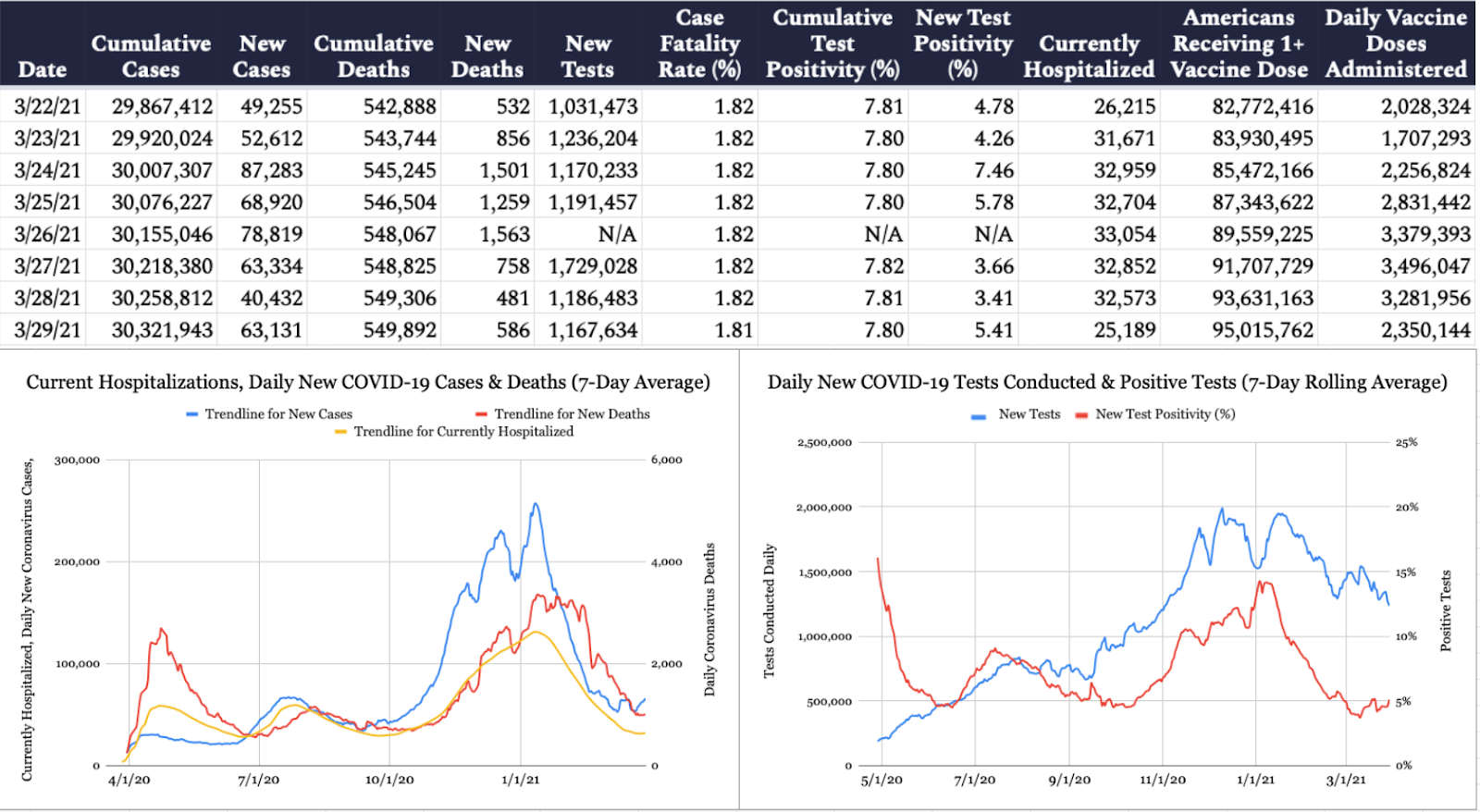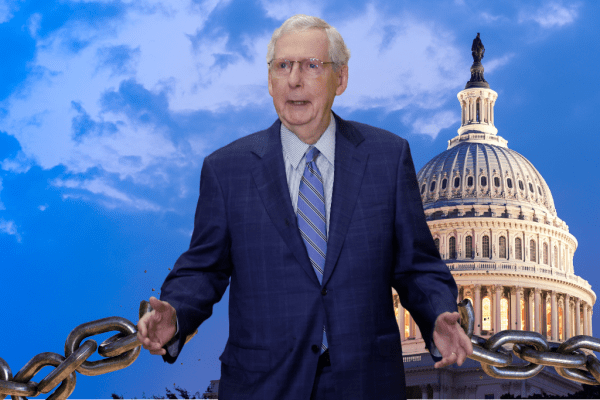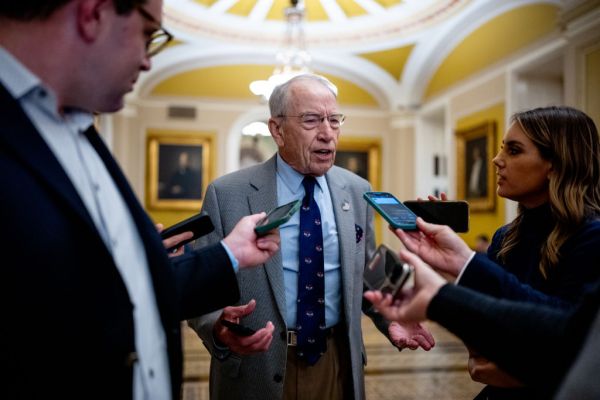Happy Tuesday! This is officially a pro-extending Anthony Rizzo newsletter. Get it done, Cubs!
Quick Hits: Today’s Top Stories
-
A real-world Centers for Disease Control (CDC) study of health care and frontline workers found the Moderna and Pfizer COVID-19 vaccines to be incredibly effective. No deaths were reported in the study, and just three of 2,479 fully vaccinated people tracked developed a COVID-19 infection, compared to 161 of the 994 people in the study who were not vaccinated.
-
The CDC announced Monday it is extending the nationwide eviction moratorium, which was set to expire this week, through June 30 in an effort to help tenants late on rent and prevent overcrowding in homeless shelters.
-
President Joe Biden pledged on Monday that “at least 90 percent” of American adults who want a COVID-19 vaccine will be eligible to receive one within the next three weeks at a vaccination site “within five miles” from their home. Biden, however, also urged state leaders to remain vigilant and reinstate mask mandates to prevent another surge.
-
The Supreme Court on Monday agreed to hear a procedural case regarding state abortion restrictions brought by Kentucky Attorney General Daniel Cameron. The case, however, focuses only on who is allowed to defend such restrictions in court rather than the restrictions themselves.
-
The trial of Derek Chauvin—the Minneapolis police officer charged in the death of George Floyd—kicked off yesterday. The proceedings are expected to last weeks.
-
Longtime Jeffrey Epstein associate Ghislaine Maxwell was charged in a new indictment on Monday with the sex trafficking of a 14-year-old girl.
-
The United States confirmed 63,131 new cases of COVID-19 yesterday per the Johns Hopkins University COVID-19 Dashboard, with 5.4 percent of the 1,167,634 tests reported coming back positive. An additional 586 deaths were attributed to the virus on Monday, bringing the pandemic’s American death toll to 549,892. According to the Centers for Disease Control, 25,189 Americans are currently hospitalized with COVID-19, and 2,350,144 COVID-19 vaccine doses were administered yesterday. 95,015,762 Americans have now received at least one dose.

World Health Organization Issues COVID Origin Report
Earlier this year, a team of World Health Organization (WHO) researchers traveled to Wuhan for the first time since the dawn of the pandemic to determine—in collaboration with Chinese scientists—how COVID-19 first began to spread in the Chinese province in late 2019 and early 2020. Their full report is set to be released today; draft copies leaked yesterday to several news outlets.
But despite the fanfare over the long-awaited document, it contains little that’s actually new. We already knew the broad contours of what the WHO team was going to say: After two weeks of work, which included visits to the Huanan Seafood Wholesale Market and the Wuhan Institute of Virology, the team announced their preliminary findings in early February. What they said provoked much crowing from Chinese state media and some significant skepticism everywhere else.
As we reported at the time, it wasn’t the topline finding that cocked any eyebrows. The team—which was trying to chase a year-old trail—hewed to the conventional wisdom that the virus had most likely jumped from wild animals to humans by means of an intermediary host, like an animal at market. Rather, it was the way the WHO had handled two other possible explanations: The first, that the virus had escaped from a nearby research lab, which had been conducting research on bat coronaviruses; the second, that it had not originated in Wuhan at all, but had been introduced to the area on frozen-food products from another country.
Both explanations are merely theories—lacking specific public evidence, but having a certain explanatory power. (The virus got to Wuhan somehow, and the nearest wild animal populations harboring similar coronaviruses were a thousand miles away.) But most scientists agree that the cold-chain theory is a stretch even in a theoretical sense: We don’t know whether virus particles on frozen food packaging are even capable of making the jump to infect humans. (Recall that COVID-19 is a respiratory disease spread primarily through the inhalation of the virus.)
Nevertheless, Chinese propaganda has relentlessly disavowed the lab-leak theory and pushed the cold-chain theory as all but established fact—unsurprisingly, given that that theory would allow them to shift the blame for the initial outbreak to another country. (America, usually.) When the WHO scientists offered their initial findings in February, they surprised many by elevating the latter (which they judged unlikely, but not impossible) above the lab-leak theory (which they all but ruled out). But they did hasten to add that they considered the animal transmission theory likeliest.
In the final report, the WHO appears to have dialed up its skepticism of the cold-chain theory at least a notch or two. “While there is some evidence for possible reintroduction of SARS-CoV-2 through handling of imported contaminated frozen products in China since the initial pandemic wave,” the report reads, “this would be extraordinary in 2019 where the virus was not widely circulating.”
That may not be enough to save the report from continued skepticism, however. Robert Redfield, the virologist who served as CDC director under President Donald Trump, made headlines over the weekend when CBS aired an interview in which he said that “I still think the most likely etiology of this pathogen in Wuhan was from a laboratory—you know, escaped.”
That’s not particularly surprising, given that Republicans have long been likelier than Democrats to entertain the lab theory. More remarkable were comments from Secretary of State Antony Blinken, who told CNN that “we’ve got real concerns about the methodology and the process that went into that report, including the fact that the government in Beijing apparently helped to write it.”
A plethora of experts have pointed out similar problems with the investigation. “I wouldn’t really call what’s happened now an investigation,” Jamie Metzl, a former NSC official who serves on a WHO committee, told CBS on Sunday. “It’s essentially a highly chaperoned, highly curated study tour. … That’s because of the ground rules China set with the WHO, which has never had the authority to make demands or enforce international protocols.”
China’s restrictions on the WHO’s mission were “appalling, as a matter of fact,” Dr. William Schaffner, an epidemiologist at Vanderbilt University, told The Dispatch. “It’s outrageous. It’s amazing. It’s appalling. The WHO should say, ‘We have to go do this, and unless we get complete access we’re not doing it and we’re condemning you.’”
COVID Cases Rise, But So Do Vaccinations
When we wrote to you with a pandemic update a few weeks ago, public health experts were warning of one more COVID-19 surge, similar to what the European Union was experiencing at the time. “We know from previous surges that we’ve had over the year that when you see that leveling off at a high level, there’s always the risk of a surge back up,” Dr. Anthony Fauci told Fox News Sunday on March 14. “And, in fact, unfortunately, that’s exactly what is happening in Europe right now.”
Two weeks later, new cases in the United States are beginning to trend upward—albeit modestly—once again. In the first week of March, the country averaged just under 57,000 new cases per day; last week, that number was nearly 62,300. COVID-19 hospitalizations have begun to plateau, too, at a level four times lower than the early-January peak.

CDC Director Dr. Rochelle Walensky tried to sound the alarm in a White House briefing on Monday, saying she’s experiencing a feeling of “impending doom.”
“We do not have the luxury of inaction. For the health of our country, we must work together now to prevent a fourth surge,” she said. “I so badly want to be done. I know you all so badly want to be done. We are just almost there, but not quite yet.”
What’s driving the resurgence? Likely a combination of new, more transmissible variants and pandemic fatigue. States across the country—from Texas to Connecticut, Mississippi to Maryland—have been loosening coronavirus restrictions in recent weeks, but it’s Michigan, Massachusetts, New York, and New Jersey that are struggling the most with this latest uptick. The B.1.1.7 COVID-19 variant is particularly prevalent in Michigan and Florida, per CDC data.
“The variants are playing a part, but it is not completely the variants,” Fauci told CBS News over the weekend. “What we’re likely seeing is because of things like spring break and pulling back on the mitigation methods that you’ve seen.”
But this uptick is unlike previous surges: We’ve got the vaccines. As of this morning, the CDC reports that 94.7 million American adults (36.7 percent of the 18+ population) have received at least one vaccine dose, and 52.5 million (20.4 percent) are fully vaccinated. Even more importantly, given what we know about risk factors for severe COVID-19, nearly three in four Americans over 65 (72.8 percent) have gotten at least one dose, and nearly 50 percent are all set. That fact—along with fatalities being a lagging indicator—can help explain why COVID-19 deaths have continued to fall even as cases are rising.
“Israel started to see the big declines in cases when they hit about 25 percent of their population vaccinated,” former Food and Drug Administration Commissioner Scott Gottlieb said on Face the Nation this Sunday. “If we could just get two or three more weeks of around three million vaccines a day, that’s going to be a pretty big backstop against a true fourth surge.”
The U.S. averaged about 2.8 million shots per day last week, up from 2.5 million the week prior. The pace is only going to continue accelerating as Johnson & Johnson ramps up production of its single-shot vaccine and states build out their distribution infrastructure while opening up eligibility. In remarks yesterday, President Biden pledged that 90 percent of Americans would be eligible for a COVID-19 vaccine within three weeks, and that 90 percent of Americans will have a vaccination center available to them within five miles of their home.
“We’re going to do this by growing from having 17,000 pharmacies giving out vaccination shots to nearly 40,000 pharmacies doing it within the next three weeks,” he said. “In the next three weeks, we’ll add 12 more federally run mass vaccination sites.”
But the president urged caution, as he and his administration have consistently done since taking office 10 weeks ago. “As many people as we have vaccinated, we still have more Americans left to go,” he said. “We will administer more shots in March than any country on earth. But even so, we have to give more shots in April than we did in March, because we’re in the life and death race for the virus that is spreading quickly with cases rising again. New variants are spreading, and sadly, some of the reckless behavior we’ve seen on television over the past few weeks means that more new cases are to come in the weeks ahead.”
But other public health experts were more optimistic. “We’re doing as well as one could possibly do at this point,” Dr. Paul Offit, the director of the Vaccine Education Center at the Children’s Hospital of Philadelphia, told The Dispatch. “We just isolated this virus in January of 2020, and now a little more than a year later, you have three excellent vaccines that are rolling out into this country. … You have more than 15 percent of people who have been fully immunized, we’re getting as many as 3 million doses a day out there.”
Vanderbilt’s Dr. Schaffner expressed a similar sentiment, giving the United States’ current pandemic response a “B+” grade. “We’re recovering, we have structure, we have coherence, we have sustained communication.”
Worth Your Time
-
Armed with the scholarship of decades of researchers before them, scientists at Moderna and Pfizer developed their mRNA COVID-19 vaccines at a breakneck speed. Now, pharmaceutical companies are looking to the future, investigating the ways in which synthetic mRNA can be used to fight diseases like malaria, the seasonal flu, multiple sclerosis, and even certain forms of cancer. “People rely on proteins for just about every bodily function; mRNA—which stands for messenger ribonucleic acid—tells our cells which proteins to make,” Derek Thompson writes in an Atlantic story explaining the medical breakthrough. “With human-edited mRNA, we could theoretically commandeer our cellular machinery to make just about any protein under the sun.”
-
Beverly Cleary, the prolific children’s author, died last week at the age of 104. In Literary Hub Magazine, Rachel Vorona Cote penned a sweeping ode to Ramona Quimby, Cleary’s most notable character, and how she shaped the “plucky heroine” literary archetype for the better. “Ramona loves the world with ferocity; she does not so much want to disturb it as she yearns to discover, to turn it over, examine every piece and crook and marvel at why each creature, commodity, and substance exists the way it does,” Cote writes. “If Ramona senses that her impulses are not always compatible with suburban niceties, she refuses to diminish herself. Her character is not a problem to be solved.”
Presented Without Comment
Also Presented Without Comment
Toeing the Company Line
-
On the website: Bill Wirtz on Europe and Turkey, and Audrey on Michael Wood, an anti-Trump candidate for Texas’ 6th congressional district.
-
On Monday’s Advisory Opinions, David and Sarah discussed the Supreme Court’s March 25 ruling in Torres v. Madrid, a Fourth Amendment case involving a failed attempt by police officers to restrain a suspect using physical force. Plus: The legal history surrounding hate crimes, the constitutionality of D.C. statehood, and some career advice for aspiring lawyer listeners.
Let Us Know
We haven’t done a COVID-19 status update in a while. If you were already vaccinated the last time we asked, how’s life on the other side? Do things feel pretty “normal?”
If not, have you been since? When do you expect to get the jab?
Reporting by Declan Garvey (@declanpgarvey), Andrew Egger (@EggerDC), Haley Byrd Wilt (@byrdinator), Audrey Fahlberg (@FahlOutBerg), Charlotte Lawson (@charlotteUVA), Ryan Brown (@RyanP_Brown), and Steve Hayes (@stephenfhayes).








Please note that we at The Dispatch hold ourselves, our work, and our commenters to a higher standard than other places on the internet. We welcome comments that foster genuine debate or discussion—including comments critical of us or our work—but responses that include ad hominem attacks on fellow Dispatch members or are intended to stoke fear and anger may be moderated.
You are currently using a limited time guest pass and do not have access to commenting. Consider subscribing to join the conversation.
With your membership, you only have the ability to comment on The Morning Dispatch articles. Consider upgrading to join the conversation everywhere.